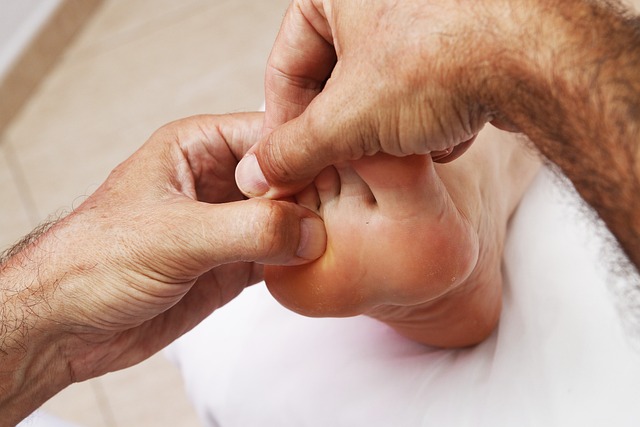This text explores cold therapy as a natural and effective approach to managing migraines. It highlights that while various triggers like foods and stress cause migraines, cold therapy—including ice packs, cryotherapy, and cold water immersions—can provide significant relief by constricting brain blood vessels and reducing inflammation. Personalized trigger point identification is key to unlocking the full potential of cold therapy, allowing individuals to customize their treatments for more effective migraine management. Regular tracking of progress and adjustments to techniques ensure optimal benefits, making cold therapy a valuable tool for reducing migraine frequency and intensity over time.
Discover the power of cold therapy as a potent tool in your migraine management arsenal. This comprehensive guide unveils the science behind identifying trigger points for effective cold application, transforming your approach to headache relief. From understanding migraine triggers and the role of cryotherapy to exploring diverse cold therapy methods and tracking progress, you’ll learn how cooling techniques can provide lasting migraine pain relief. Embrace a new era of migraine care with ice packs, water immersion, and more.
Understanding Migraine Triggers and Cold Therapy's Role
Understanding Migraine Triggers and Cold Therapy’s Role
Migraines are intense, debilitating headaches that can significantly impact daily life. While the exact causes vary from person to person, identifying specific triggers is a crucial step in managing and preventing these episodes. Common triggers include certain foods, stress, lack of sleep, hormonal changes, and environmental factors like bright lights or loud noises. Among these, cold therapy has emerged as a powerful tool for migraine relief and management.
Cold therapy involves applying cooling techniques such as ice packs, cryotherapy sessions, or even cold water immersions to alleviate migraine pain. The benefits of cold compresses for headaches are well-documented; they help constrict blood vessels in the brain, reducing inflammation and distracting the mind from the intense pain. This simple yet effective method offers a natural alternative for those seeking relief from migraine symptoms without relying heavily on medications.
Identifying Personalized Trigger Points for Effective Cold Application
Identifying personalized trigger points is key to unlocking the full potential of cold therapy for migraines and other headaches. Unlike one-size-fits-all approaches, such as applying an ice pack or using a simple cold compress, understanding your unique pain response allows for targeted cryotherapy techniques. This might involve exploring different cooling methods like cold water immersion or even experimental treatments like cryostimulation. By pinpointing areas of heightened sensitivity and tension, individuals can customize their application methods—be it through strategic placement of ice packs or immersing affected limbs in chilled water—for more effective migraine pain relief.
The benefits of personalized cold therapy extend beyond temporary migraine relief. It empowers folks to actively participate in managing their condition. Regular use of cooling techniques can reduce the frequency and intensity of headaches over time, offering a natural and non-invasive way to navigate the challenges posed by migraines. This tailored approach encourages individuals to become more attuned to their bodies, enabling them to swiftly employ effective cold therapy for migraines whenever needed.
Exploring Different Cold Therapy Methods for Migraine Relief
Exploring Different Cold Therapy Methods for Migraine Relief
For individuals seeking effective migraine management, cold therapy offers a promising avenue. The application of cold can significantly alleviate migraine pain by reducing inflammation and constricting blood vessels in the head. One of the simplest and most accessible methods is using an ice pack. Applying an ice pack to the forehead or the back of the neck can provide immediate relief, numbing the affected areas and easing the throbbing sensation associated with migraines.
Beyond ice packs, other cold therapy techniques such as cryotherapy and cold water immersion have shown promising results. Cryotherapy involves brief exposure to extremely cold temperatures, which can help reduce muscle tension and inflammation. Cold water immersion, on the other hand, involves submerging oneself in cold water, promoting blood flow changes that may contribute to reduced migraine symptoms. These cooling techniques for headaches offer a range of benefits, from rapid pain relief to potential long-term reduction in migraine frequency and severity.
Tracking Progress and Adjusting Cold Therapy Techniques
Tracking progress and adjusting your cold therapy techniques is a vital step in achieving effective migraine relief. After several treatments, assess how your body responds to different cooling methods like ice packs, cold water immersions, or cryotherapy sessions. Keep a log of the frequency and duration of each session, as well as any associated pain levels before and after. This data will help you identify what works best for your specific case. If, for example, you find that while an ice pack provides significant relief during acute migraine attacks, cryotherapy becomes more effective over time in preventing recurring headaches, adjust your treatment plan accordingly.
Regularly reviewing and modifying your cold therapy approach ensures optimal benefits. Be open to experimenting with different cooling techniques, application areas (e.g., neck, temples, or scalp), and durations until you find the perfect combination for your migraine pain relief. This personalized approach leverages the natural anti-inflammatory and analgesic properties of cold compresses, which have been shown to be effective in reducing inflammation and numbing pain receptors, providing lasting migraine relief.
By identifying personal trigger points and utilizing various cold therapy methods like ice packs, cryotherapy, and cold water immersion, individuals can effectively manage and reduce migraine pain. Tracking progress and adjusting cooling techniques as needed ensures optimal migraine relief. Incorporating these strategies into a comprehensive approach, alongside understanding one’s unique triggers, can lead to significant improvements in managing this debilitating condition, offering a promising natural alternative for those seeking effective headache alleviation.
